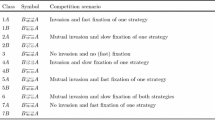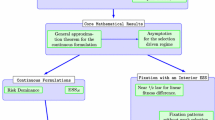Abstract
The Cannings exchangeable model for a finite population in discrete time is extended to incorporate selection. The probability of fixation of a mutant type is studied under the assumption of weak selection. An exact formula for the derivative of this probability with respect to the intensity of selection is deduced, and developed in the case of a single mutant. This formula is expressed in terms of mean coalescence times under neutrality assuming that the coefficient of selection for the mutant type has a derivative with respect to the intensity of selection that takes a polynomial form with respect to the frequency of the mutant type. An approximation is obtained in the case where this derivative is a continuous function of the mutant frequency and the population size is large. This approximation is consistent with a diffusion approximation under moment conditions on the number of descendants of a single individual in one time step. Applications to evolutionary game theory in finite populations are presented.
Similar content being viewed by others
References
Abramowitz M., Stegun I.A. (1965). Handbook of Mathematical Functions. Dover, New York
Cannings C. (1974). The latent roots of certain Markov chains arising in genetics: a new approach. I. Haploid models. Adv. Appl. Probab. 6: 260–290
Cherry J.L. (2003). Selection in a subdivided population with dominance or local frequency dependence. Genetics 163: 1511–1518
Eldon B., Wakeley J. (2006). Coalescent processes when the distribution of offspring number among individuals is highly skewed. Genetics 172: 2621–2633
Ewens, W.J.: Mathematical Population Genetics 1. Theoretical Introduction, 2nd edn. Springer, New York (2004)
Fisher R.A. (1930). The Genetical Theory of Natural Selection. Clarendon, Oxford
Hofbauer J., Sigmund K. (1988). The Theory of Evolution and Dynamical Systems. Cambridge University Press, Cambridge
Imhof L.A., Nowak M.A. (2006). Evolutionary game dynamics in a Wright–Fisher process. J. Math. Biol. 52: 667–681
Karlin S., Taylor H.M. (1981). A Second Course in Stochastic Processes. Academic, New York
Kingman, J.F.C.: Exchangeability and the evolution of large populations. In: Koch, G., Spizzichino, F. (eds.) Exchangeability in Probability and Statistics, pp. 97–112. North-Holland, Amsterdam (1982)
Lambert A. (2006). Probability of fixation under weak selection: a branching process unifying. Theoret. Popul. Biol. 69: 419–441
Lessard S. (1984). Evolutionary dynamics in frequency-dependent two-phenotype models. Theoret. Popul. Biol. 25: 210–234
Lessard S. (2005). Long-term stability from fixation probabilities in finite populations: New perspectives for ESS theory. Theoret. Popul. Biol. 68: 19–27
Leturque H., Rousset F. (2002). Dispersal, kin selection and the ideal free distribution in a spatially heterogeneous population. Theoret. Popul. Biol. 62: 169–180
Maynard Smith J. (1974). The theory of games and the evolution of animal conflicts. J. Theoret. Biol. 47: 209–221
Maynard Smith J., Price G.R. (1973). The logic of animal conflict. Nature 246: 15–18
Möhle M. (1998). Robustness results for the coalescent. J. Appl. Probab. 35: 438–447
Möhle M. (2004). The time back to the most recent common ancestor in exchangeable population models. Adv. Appl. Probab. 36: 78–97
Möhle M., Sagitov S. (2001). A classification of coalescent processes for haploid exchangeable population models. Ann. Probab. 29: 1547–1562
Moran P.A.P. (1958). Random processes in genetics. Proc. Camb. Philos. Soc. 54: 60–71
Nowak M.A., Sasaki A., Taylor C., Fudenberg D. (2004). Emergence of cooperation and evolutionary stability in finite populations. Nature 428: 646–650
Orzack S.H., Hines W.G.S. (2005). The evolution of strategy variation: will an ESS evolve?. Evolution 59: 1183–1193
Pitman J. (1999). Coalescents with multiple collisions. Ann. Probab. 27: 1870–1902
Proulx S.R. (2000). The ESS under spatial variation with applications to sex allocation. Theoret. Popul. Biol. 58: 33–47
Rousset F. (2003). A minimal derivation of convergence stability measures. J. Theoret. Biol. 221: 665–668
Rousset F., Billiard S. (2000). A theoretical basis for measures of kin selection in subdivided populations: Finite populations and localized dispersal. J. Evol. Biol. 13: 814–825
Roze D., Rousset F. (2004). The robustness of Hamilton’s rule with inbreeding and dominance: Kin selection and fixation probabilities under partial sib mating. Am. Nat. 164: 214–231
Sagitov S. (1999). The general coalescent with asynchronous mergers of ancestral lines. J. Appl. Probab. 36: 1116–1125
Tavaré, S., Zeitouni, F.: Lectures on Probability Theory and Statistics, Ecole d’Été de Probabilités de Saint-Flour XXXI - 2001, Lecture Notes in Mathematics, Vol. 1837, Springer, New York (2004)
Taylor C., Nowak M.A. (2006). Evolutionary game dynamics with non-uniform interaction rates. Theoret. Popul. Biol. 69: 243–252
Wild G., Taylor P.D. (2004). Fitness and evolutionary stability in game theoretic models of finite populations. Proc. R. Soc. B 271: 2345–2349
Wright S. (1931). Evolution in Mendelian populations. Genetics 16: 97–159
Author information
Authors and Affiliations
Corresponding author
Rights and permissions
About this article
Cite this article
Lessard, S., Ladret, V. The probability of fixation of a single mutant in an exchangeable selection model. J. Math. Biol. 54, 721–744 (2007). https://doi.org/10.1007/s00285-007-0069-7
Received:
Revised:
Published:
Issue Date:
DOI: https://doi.org/10.1007/s00285-007-0069-7
Keywords
- Exchangeable model
- Coalescence times
- Diffusion approximation
- Evolutionary game theory
- Fixation probability




